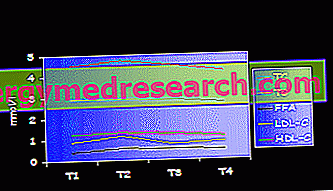Generality
Hemoglobin is a protein containing four iron atoms, essential for the transport of oxygen from the lungs to various body tissues. In addition, the same molecule is responsible for conveying part of the carbon dioxide from the tissues that produced it to the lungs.

What's this
Hemoglobin (Hb) is a protein found inside red blood cells.
With its presence, it guarantees a fundamental function for the body: that of transporting oxygen from the lungs to the tissues, in all the districts of the body. On his return journey into venous blood, hemoglobin transports carbon dioxide to the lungs, from which it is expelled with exhaled air.
For this reason, it is important that the hemoglobin values are carefully evaluated: its deficiency leads to a state of anemia, as well as weakness and various other disorders.
There are several defects in the genes of globine and EME. These can give rise to diseases such as thalassemia and porphyria.
Why do you measure
The test is used to determine the concentration of hemoglobin in the blood.
This value is measured by the hematocrit (blood test that indicates the percentage ratio between the red blood cells and the plasma) or the blood count, as an integral part of the health status assessment.
The hemoglobin test may be required for several reasons:
- For a routine check-up : your doctor may request the exam as part of a general screening.
- For the diagnosis of a medical condition : the doctor may suggest a hemoglobin test when he suspects that the patient has a disease such as anemia (decreased hemoglobin) or polycythemia (increased hemoglobin), or when the patient develops disorders such as weakness, fatigue, shortness of breath or dizziness.
- To monitor a disease or treatment responses : the doctor can take the exam to monitor a series of conditions and conditions that affect red blood cells and / or the amount of hemoglobin in the blood. The test can also be used to evaluate the efficacy of the treatment when the patient has been diagnosed with bleeding problems, anemia or polycythemia. Furthermore, the examination can be prescribed during chemotherapy protocols for the treatment of a tumor.
Together with the hematocrit and the blood count, to determine the exact cause on which the alteration of hemoglobin values depends, other analyzes can be performed, such as:
- Blood smear;
- Reticulocyte count (transition elements between nucleated erythroblasts and red blood cells, present both in bone marrow and in peripheral blood);
- Bone marrow biopsy.
Hemoglobin analysis: what is electrophoresis?
Hemoglobin electrophoresis is an exam that allows the evaluation of the presence or absence of abnormal hemoglobin forms. If this protein has an unconventional form, then it is not able to efficiently transport oxygen to the tissues.
The physical principle on which electrophoresis is based consists of an analytical-separative technique, which makes it possible to evaluate the movement of electrically charged particles under the influence of an electric field, if they are in a fluid medium.
With this analytical technique the most common hemoglobin abnormalities are diagnosed, such as Mediterranean anemia (or beta-thalassemia).
Normal values
The normal values of hemoglobin are strictly dependent on the age and sex of the subject.
Below are the average reference intervals for each individual patient group:
- Babies: 17-22 g / dl
- Babies (one week old): 15-20 g / dl
- Infants (one month old): 11-15 g / dl
- Children: 11-13 g / dl
- Adult males: 14-18 g / dl
- Adult females: 12-16 g / dl
- Men after middle age: 12.4-14.9 g / dl
- Women after middle age: 11.7-13.8 g / dl
These thresholds may however vary slightly from one analysis laboratory to another. For this reason, it is always necessary to refer to the intervals reported on the examination report.
Note
For pregnant women and children, hemoglobin values may be lower than the norm due to relative iron deficiency in the face of an increased body requirement.
High Hemoglobin - Causes
In general, one speaks of HIGH HEMOGLOBIN when its concentrations in the blood rise above 17.5 grams per deciliter of blood in humans, and above 15 grams per deciliter in women. However, these thresholds may vary slightly from one analysis laboratory to another or be corrected for age (the values reported are those typical of adults).
High values of hemoglobin in the blood can be consequent to:
- Homeostatic response to low oxygen levels, resulting from chronic lung diseases or heart disease;
- Increased release of erythropoietin by the kidney;
- Taking synthetic erythropoietin or drugs that stimulate synthesis;
- Bone marrow dysfunctions that result in excessive red blood cell synthesis;
- Extended stay in height.
Examples of diseases and conditions that can increase hemoglobin values in the blood:
- COPD;
- Blood doping (erythropoietin, epoetin, mircera etc.);
- Dehydration;
- Emphysema;
- Heart failure;
- Renal carcinoma;
- Hepatic carcinoma;
- Polycythemia;
- Smoking habit;
- polycythemia;
- Diarrhea;
- Burns;
- Repeated transfusions
When present, the SYMPTOMS associated with an increase in hemoglobin include:
- Vision disorders;
- Dizziness;
- Headache;
- Red color of the face;
- Spleen enlarged.
Low Hemoglobin - Causes
Generally speaking, it is called LOW HEMOGLOBIN when its blood concentrations fall below 13.5 grams per deciliter of blood in humans, and below 12 grams per deciliter in women. However, these thresholds may vary slightly from one analysis laboratory to another or be corrected for age (the values reported are those typical of adults).
The finding of low hemoglobin values is quite frequent. In most cases the deficiency is slight, separated from any pathological condition and foreign to any symptom. This condition is more frequent in women, considering the blood loss connected to the menstrual cycle and the more frequent habit to follow low-calorie diets that are poor in meat (which is the best food source of iron). Even during pregnancy, hemoglobin levels typically tend to decrease.
At other times, the hemoglobin values decrease too much due to the presence of various pathologies. Anemia can for example be consequent to:
- An insufficient synthesis of red blood cells:
- Aplastic anemia;
- carcinomas;
- Some drugs (chemotherapy, anti-retroviral drugs);
- Cirrhosis;
- Hodgkin's lymphoma;
- Hypothyroidism;
- Iron deficiency (iron deficiency anemia);
- Kidney diseases;
- Lead poisoning;
- Multiple myeloma;
- Leukemia;
- Myelodysplastic syndromes;
- Non-Hodgkin's lymphoma;
- Malnutrition and vitamin deficiencies (B6, B12, B9 in the first place).
- An excessive catabolism of red blood cells:
- Splenomegaly (enlarged spleen);
- Thalassemia;
- Vasculitis;
- Sickle cell anemia;
- Porphyria.
- Acute or chronic bleeding processes:
- Bleeding from a wound;
- Too frequent blood donations;
- Hypermenorrhea (presence of a particularly abundant menstrual flow);
- Frequent epistaxis (recurrent nose blood);
- Gastro-intestinal bleeding (gastric ulcer, colon cancer ...) or urinary.
When present, the SYMPTOMS associated with low hemoglobin values include:
- Chronic generalized fatigue;
- Reduced tolerance to physical exercise;
- Shortness of breath;
- Pallor;
- Clear gums;
- Tachycardia during physical activity.
How to measure it
The hemoglobin test is performed by a simple blood test. The sample is taken from the vein of an arm or by a puncture of the finger or heel (newborns).
Preparation
The sample is usually taken in the morning. To perform the analysis, the patient must observe a fast of at least 8 hours, in which it is allowed to take only a modest amount of water.
Interpretation of Results
Since the evaluation of hemoglobin is often performed as part of a blood count, the results of other blood components should also be taken into consideration.
The increase or reduction of the hemoglobin concentration must be interpreted together with other parameters, such as the reticulocyte count and / or the red cell indexes. In general, hemoglobin reflects the result of red blood cell count and hematocrit.



